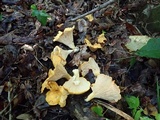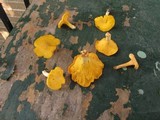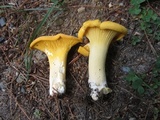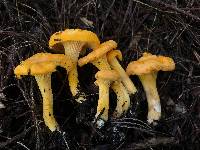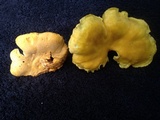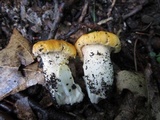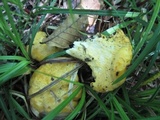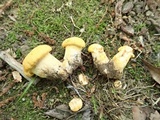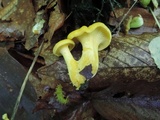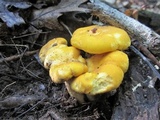
|
|
|
|
Family: Cantharellaceae
|
Foltz MJ, Perez KE, Volk TJ. 2013. Molecular phylogeny and morphology reveal three new species of Cantharellus within 20 m of one another in western Wisconsin, USA. Mycologia 105: 447-461. Cantharellus flavus M.J. Foltz & T.J.Volk, sp. nov. Fig. 1C, D, E, SUPPLEMENTARY FIG. 4 Mycobank MB800426, C0171585F. Pileus yellow; hymenium yellow; stalk yellow; spore print yellow. Molecular data from ITS and TEF1 loci distinguish this species from all other Cantharellus (Figs. 4, 5). Etymology: named flavus for the yellow stipe, hymenium, pileus and spore print. Holotypus: UNITED STATES. WISCONSIN: La Crosse County, Hixon Forest Park, along the path parallel to Bliss Road, approximately halfway up the path when heading uphill, on right side, associated with Quercus (oak) in oak-hickory mixed deciduous forest, N43.8157° W91.2091°, 18-VII-2010, here designated Foltz C066, Collection CF001, C0171585F. Pileus egg-yellow or paler with age or exposure to light, 6–9 cm diam, plano-convex when immature, becoming plane to wavy and depressed to broadly infundibuliform; margin incurved, regular to irregular, usually everted when mature, sometimes lobed or sinuate on one side, context yellowish, thin, somewhat spongy and watery in texture; lamellae deeply decurrent, egg-yellow, often forking and anastomosing, not readily staining when bruised, bruises appear ochraceous brownish yellow in dried specimens; stipe yellow and solid, sometimes patched with white and mottled in age, 3–8 cm long, 0.5–2 cm thick, context yellowish white; spore deposit yellow, (7.5)8–10(11) × (4)4.5–6 μm, subglobose to obovate when young, becoming oblong with maturity (n = 30); basidia (63)75–80(84) × 7–9(10) μm, 4–6 sterigmate, clavate, often undulate; pileus hyphae with a long terminal cell (78)85–95(100) × 4.5–5.5(6) μm, sometimes with thickened walls; clamps found in all tissues; odor fragrant like apricots; flavor slightly peppery; KOH intensifying color of all tissues. Habitat, habit and distribution: cespitose to gregarious; associated with Quercus (Fagaceae) and Carya (Juglandaceae) (oak-hickory); on well drained soil, especially on hillsides; common Jul–Aug in western Wisconsin, presumably more widespread. Edibility: choice. Additional specimens examined: UNITED STATES. WISCONSIN: La Crosse County, Hixon Forest Park, along the path running parallel to Bliss Road, associated with oak in oak-hickory mixed deciduous forest, 18-VII-2010, CF001; UNITED STATES. WISCONSIN: La Crosse County, Hixon Forest Park, on hillside, behind the National Weather Service Station on County Highway FA, 18-VIII-2009, CF002. C0171586F. Comments: This species is most easily distinguished from other chanterelles by its yellow hymenium, stalk, and spore print. We suggest the common name “Midwestern yellow chanterelle” for this species. |
|
|
|






